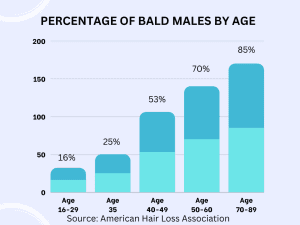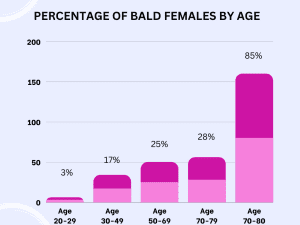Hair loss, medically known as alopecia, is a prevalent concern affecting millions worldwide. While it’s often associated with aging, it can impact individuals of various ages, genders, and ethnicities. In this article, we delve into the latest hair loss statistics for 2023, shedding light on the extent of percentage of bald males by country, age groups, and demographics.
Global Overview: Androgenetic Alopecia on the Rise
Androgenetic alopecia, commonly referred to as male-pattern baldness or female-pattern baldness, is the most widespread form of hair loss. This genetic predisposition leads to hair thinning and baldness, affecting both men and women. Recent statistics reveal that about 85% of men and 33% of women worldwide will eventually experience androgenetic alopecia.
Approximately 35 million men and 21 million women are grappling with hair loss, making it a significant concern that transcends geographical boundaries. This condition can have profound psychological and emotional effects, impacting self-esteem and quality of life.
Percentage Of Bald Males By Country: A Comparative Analysis
Countries exhibit varying degrees of male baldness, shedding light on potential genetic and environmental factors contributing to this phenomenon. Here is a breakdown of baldness percentages in select countries:
| Country | Percentage Of Bald Males |
|---|---|
| Czech Republic | 42.79% |
| Spain | 42.6% |
| Germany | 41.2% |
| France | 39.24% |
| United Kingdom | 39.23% |
| Italy | 39.17% |
| Netherlands | 38.9% |
| United States | 37.89% |
| Canada | 36.29% |
| Belgium | 36.02% |
| Switzerland | 33.81% |
| Australia | 32.83% |
| Sweden | 32.76% |
| Greece | 31.9% |
| Norway | 31.84% |
| Austria | 31.75% |
| Denmark | 31.03% |
| Portugal | 30.98% |
| Ireland | 30.18% |
| Finland | 29.96% |
| New Zealand | 28.9% |
These figures highlight a range of baldness prevalence across nations, hinting at a combination of genetic predisposition, lifestyle, and environmental factors.
Percentage of bald males by age: A Growing Concern
Age is a critical factor in the prevalence of hair loss. As individuals grow older, the likelihood of experiencing noticeable hair loss increases. Here’s a breakdown of hair loss percentages by age based on clinical studies;
- Age 16-29: 16% of men may experience some form of hair loss/
- By age 30: Approximately 25% of individuals display some balding, and According to the American Hair Loss Association, around 66% experience some hair loss by age 35.
- By age 50: The same American Hair Loss Association also suggests that a substantial 85% may face noticeable thinning hair problems by age 50.
- By age 60: Roughly two-thirds of individuals are either bald or balding.

The statistics emphasize that hair loss becomes more pronounced with advancing age, underlining the significance of early interventions and preventive measures.
Percentage of bald males by age
In contrast to male pattern baldness, female hair loss affects many women as they age. According to a study involving 1008 women, the prevalence of female pattern hair loss varies with age. Among women aged 20-29, 3% were affected, while this percentage increased to 17% in the 30-49 age group. Among women aged 50-69, a quarter of them, or 25%, experienced this condition, and notably, 28% of women between 70 and 79 years old were affected by female pattern hair loss.

What percentage of men are bald?
Our survey revealed that, around the age of 21, approximately a quarter of men exhibit signs of mild male pattern baldness. This percentage rises to 66% by the time they reach 35 years old. By 50, a significant 85% of men will experience male baldness patterns. However, studies suggest that 30-50% of men will experience male androgenetic alopecia at 50.
Hair Loss in the United States: A Closer Look
In the United States, hair loss is a common concern affecting a substantial portion of the population. According to the American Academy Of Dermatology Association (AAD), Over 80 million Americans are grappling with this issue, showcasing its widespread prevalence. By age 35, two-thirds (2/3) 9 of men in the United States will experience some form of hair loss. This underscores the need for effective treatment options and awareness campaigns to address this widespread concern.
Conclusion: Navigating the Realm of Hair Loss
Hair loss remains a universal concern that transcends geographical, age, and gender boundaries. As the statistics show, androgenetic alopecia affects a significant portion of the global population. While genetics play a pivotal role, lifestyle factors and environmental effect can also contribute to the prevalence of hair loss.
The data presented in this hair loss statistics article underscores the importance of awareness, education, and early intervention in managing and addressing hair loss. By understanding the prevalence and factors contributing to hair loss, people can make informed decisions about their hair care routines and seek appropriate treatments when necessary.
